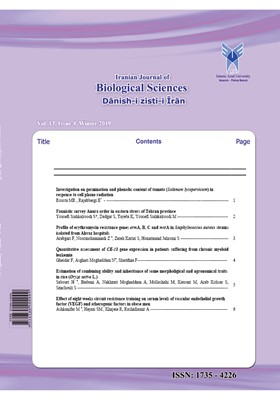Faunistic survey Anura order in eastern rivers of Tehran province
Subject Areas : ZoologySiamak Yousefi Siahkalroodi 1 , Shahram Dadgar 2 , Khurshid Tayebi 3 , Mahyar Yousefi Siahkalroodi 4
1 - Department of Biology, Faculty of Biological Sciences, Varamin-Pishva Branch, Islamic Azad University, Pishva, Iran
2 - Iran Fisheries Science Research Institute, Agricultural Research, Education and Promotion Organization, Tehran, Iran
3 - Department of Biology, Faculty of Biological Sciences, Varamin-Pishva Branch, Islamic Azad University, Pishva, Iran
4 - Faculty of Veterinary Medicine, Science and Research Branch, Islamic Azad University, Tehran, Iran
Keywords: Tehran, Jajrood, Faunistic, Anura order, Lar, Hableh Rood,
Abstract :
Identification and frequency of Anura order in south eastern cities of eastern rivers of Tehran province have been studied during 9 months of autumn 1392 and spring and summer 1393. For this reason, 10 stations have been selected in the Rivers of Jajrood, Lar and Hablehrood. After sampling by landing net, they transferred to laboratory to do identification and biometry. The results showed two subspecies, Pelophylax ridibunda ridibunda and Pseudepidalea viridis viridis and one species Rana camerani, subsist in these areas. In these stations, the dominant species in this area was Rana )Pelophylax) ridibunda ridibunda (P<0.05). Population density belonged to Rana )Pelophylax) ridibunda ridibunda, Rana camerani and Bufo (Pseudepidalea) viridis viridis, respectively (P<0.05). Subspecies Rana )Pelophylax) ridibunda ridibunda found with 83 specimens in all Rivers and stations. 50 specimens were found from Rana camerani. Samples were present in all rivers but were not collected from Khojir and Pakdasht stations at Jajrood. It was also found that Bufo (Pseudepidalea) viridis viridis subspecies was caught with only 3 specimens at Pakdasht station from Jajrood River and was not found at other rivers and stations. Distribution of these species was higher in summer than in other seasons (P<0.05). Results showed that environmental and habitat factors also influenced species distribution (P<0.05).
_||_


